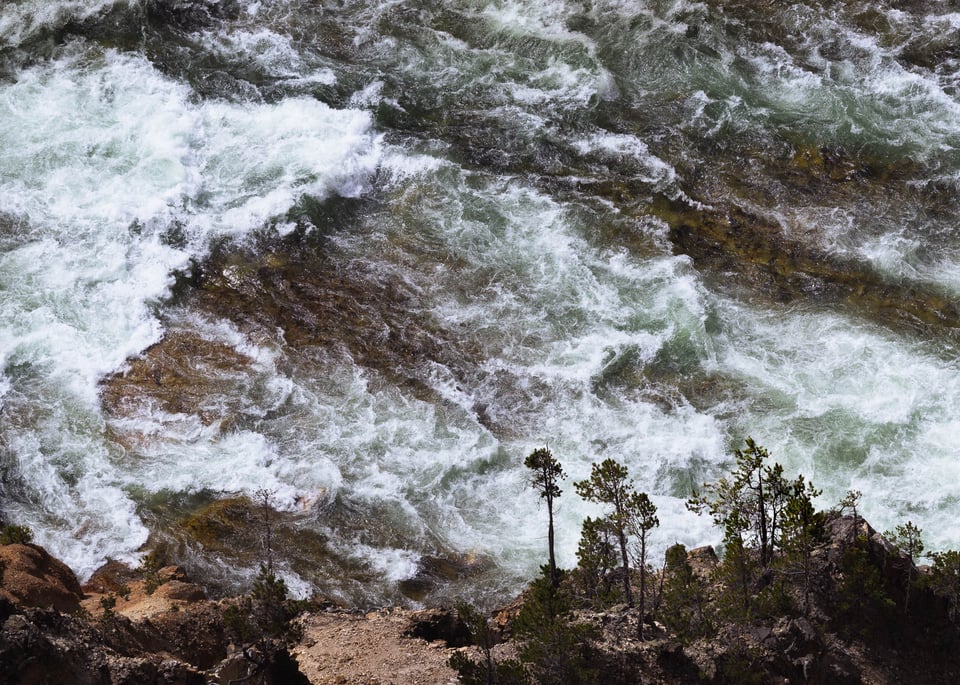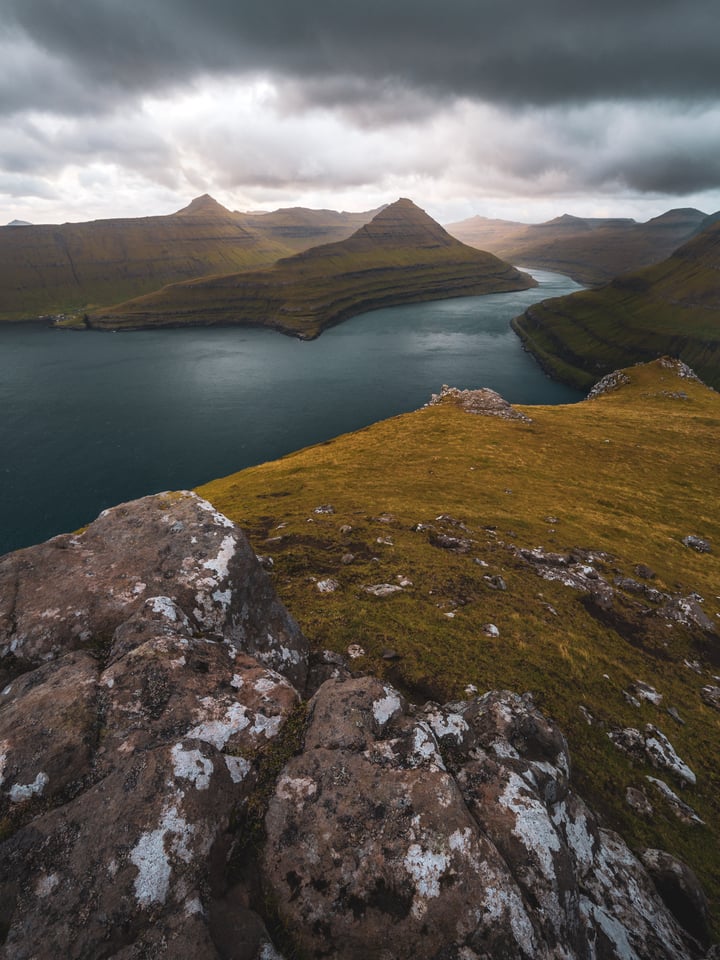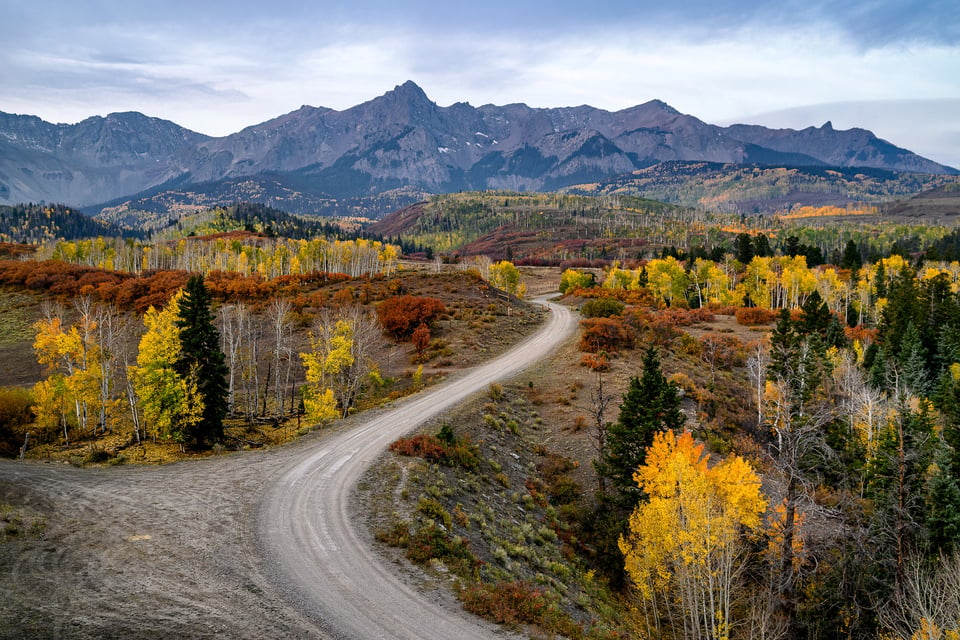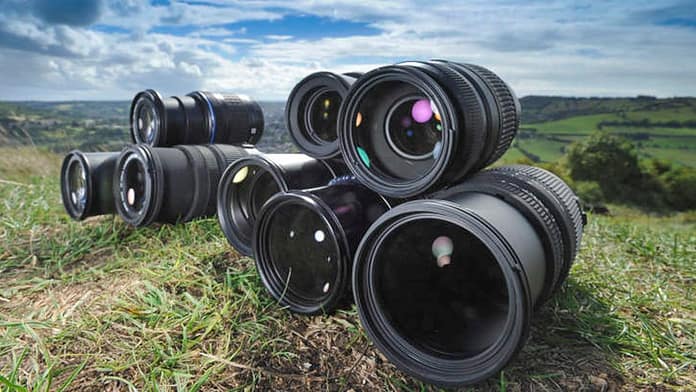To make the most of Nikon’s high-resolution 45.7-megapixel sensors, it’s best to use suitable lenses. Otherwise, you might as well save some money and get a Z6 or Z6 II instead. I’ll go through my top recommendations for both Z and F-mount lenses below.
Keep in mind that my only criterion while rating these lenses was whether the sharpness of the lens could make the most of Nikon’s 45-megapixel sensor. Although I’ll mention a few other considerations throughout this article, such as lens weight and practicality, my ratings of “recommended,” “acceptable,” etc., are based on resolution alone.

Recommended Z-Series Lenses for the Nikon Z7, Z7 II, and Z9 That Out-Resolve the 45 Megapixel Sensor
Let’s start with the Z-series lenses that work best on the Nikon 45-megapixel cameras. All else equal, I’m a fan of using native rather than adapted lenses whenever possible, especially considering that the Z lenses so far have been almost universally excellent.
First, I’ll list all the current Nikon Z lenses alongside my recommendations, with longer explanations afterward. Again, these recommendations are based solely in terms of resolving power and whether it’s capable of out-resolving Nikon’s 45-megapixel sensor.
- Highly Recommended: 14-24mm f/2.8 S
- Highly Recommended: 24-70mm f/2.8 S
- Highly Recommended: 70-200mm f/2.8 S
- Highly Recommended: 20mm f/1.8 S
- Highly Recommended: 24mm f/1.8 S
- Highly Recommended: 35mm f/1.8 S
- Highly Recommended: 50mm f/1.2 S
- Highly Recommended: 50mm f/1.8 S
- Highly Recommended: 58mm f/0.95 S
- Highly Recommended: 85mm f/1.8 S
- Highly Recommended: MC 105mm f/2.8 VR S Macro
- Highly Recommended: 400mm f/2.8 TC VR S
- Highly Recommended: 400mm f/4.5 VR S
- Highly Recommended: 600mm f/4 TC VR S
- Recommended: 14-30mm f/4 S
- Recommended: 24-70mm f/4 S
- Recommended: 24-120mm f/4 S
- Recommended: 28mm f/2.8
- Recommended: 40mm f/2
- Acceptable: 24-50mm f/4-6.3
- Acceptable: 24-200mm f/4-6.3 (at 35mm focal length alone, “recommended”)
- Acceptable: 28-75mm f/2.8 (at 28mm focal length alone, “recommended”)
- Not Recommended: 16-50mm f/3.5-6.3 DX
- Not Recommended: 50-250mm f/4.5-5.6 DX
- Not Recommended: 18-140mm f/3.5-6.3 DX VR
- Not Yet Tested: MC 50mm f/2.8 Macro
- Not Yet Tested in Lab: 100-400mm f/4.5-5.6 VR S
- Not Yet Tested: 17-28mm f/2.8
- Not Yet Tested: 800mm f/6.3 VR S
I know, I know. That’s a lot of highly recommended lenses. Kind of cheapens the category. But if you want to blame someone, blame Nikon – all of the “highly recommended” lenses out-resolve the 45-megapixel sensor, after all. This makes them best-in-class, either comparable to or better than any other lens on the market with similar focal length/aperture combinations, including Nikon’s F-mount glass.
First, let’s talk about the f/2.8 zoom trio. All three of these lenses are spectacular on the Nikon Z7, Z7 II, and Z9, with the best performance we have ever seen in zooms at these focal lengths. For example, here are our Imatest measurements from the Nikon Z 14-24mm f/2.8 at 14mm:
To put these numbers into context, take a look at Nikon’s F-mount version of the 14-24mm f/2.8, long considered one of the sharpest wide-angle zooms:
Between the two, the Z lens is far and away the sharper lens, no matter where you look in the frame or what aperture you use (aside from f/16, where almost all decent lenses look similar). In fact, the Nikon Z 14-24mm’s corners at f/2.8 are sharper than the F-mount lens’s corners ever get at 14mm. The differences only become more pronounced in favor of the Z lens at longer focal lengths. So, for Nikon Z7, Nikon Z7 II, and Nikon Z9 shooters who want a good wide-angle zoom, the Z 14-24mm f/2.8 S has my highest recommendation.
The story is similar with the Nikon Z 24-70mm f/2.8, which handily beats any other 24-70mm lens available for Nikon cameras. Even the excellent F-mount 24-70mm f/2.8E isn’t at the same level – nor are the vast majority of prime lenses on the market. Here is the Z 24-70mm f/2.8 S’s graph at 24mm:
That is simply a remarkable performance, and it remains one of the sharpest lenses on the market throughout the zoom range (though it is sharpest at the wider focal lengths). This level of sharpness borders on being unnecessary for lower resolution cameras, but on the 45-megapixel Z7 / Z7 II / Z9, it’s a very welcome sight.
As for the Nikon Z 70-200mm f/2.8, just take a look at this graph:
It even beats the 24-70mm f/2.8 S! Take a look at those central sharpness numbers; the highest resolution, amazingly, is wide open at f/2.8. The same is true at 200mm, which only has a slight drop in performance:
Those are some of the best numbers we have ever seen on a zoom – clearly up to the task of Nikon’s 45 megapixel sensor. It even beats the already excellent F-mount version in every way. In fact, no matter how many megapixels Nikon puts in its future cameras, I have a feeling the Z 70-200mm f/2.8 S is going to be sharp enough…

That’s enough about the f/2.8 trio. Our reviews of the 14-24mm f/2.8 and 70-200mm f/2.8 Z lenses are coming soon, and in the meantime, you can check out Nasim’s article on the Nikon Z trinity for the full sharpness graphs.
What about the other lenses I’ve ranked as “highly recommended”? They’re all primes, and they each set top standards in their own way. Let me go through them quickly in order of focal length.
- 20mm f/1.8 S: It’s sharper than the already great F-mount version, especially in the corners. Minimal coma makes it one of the best Milky Way lenses out there. (Some sites have reported moderate coma in their tests, but our sample had almost none – much less than the F-mount version.)
- 24mm f/1.8 S: This lens is actually a bit weaker than the Z 20mm f/1.8 S; it’s comparable to the Nikon Z 24-70mm f/2.8 S’s performance at 24mm. Still – like the 24-70mm f/2.8 S – it’s certainly enough for the Nikon Z7, Nikon Z7 II, and Nikon Z9’s 45 megapixel sensor. It also still beats the F-mount 24mm f/1.8G, itself a brilliant lens.
- 35mm f/1.8 S: Although this lens isn’t unusually sharp at f/1.8 and f/2, it sharpens dramatically by f/2.8, making it the best 35mm prime we’ve ever tested. The Nikon Z 24-70mm f/2.8 S, excellent as it is, matches the 35mm f/1.8 S’s corner performance throughout the aperture range, while falling short of the prime in the center. In any case, from f/2.8 and beyond, the Z 35mm f/1.8 S takes full advantage of the Z7 / Z7 II / Z9 sensor.
- 50mm f/1.8 S: Taking the center and corner into account, the Z 50mm f/1.8 S is the single sharpest lens we’ve ever tested. Yes, it’s a good fit for the Nikon Z7, Z7 II, and Z9.
- 50mm f/1.2 S: We are in the process of gathering Imatest data on this lens, but it’s very similar in sharpness to the 50mm f/1.8 S in the shared aperture range. Purely from an image quality standpoint, it’s an excellent match for the Nikon Z7, Z7 II, and Z9. However, the f/1.8 version is a more practical option for multiple reasons, especially price, weight, and size. Only bother with this one instead if you need f/1.2. (Of course, it doesn’t out-resolve the 45 megapixel sensor at f/1.2.)
- 58mm f/0.95 S: A highly impractical lens that we have not yet had a chance to test. Based on other sites’ tests, it may even be a bit sharper than the 50mm f/1.8 and f/1.2 lenses in their shared aperture range, so from an optical standpoint, it suits the Z7 -series cameras and the Nikon Z9 perfectly. Doesn’t matter, almost no one will buy it.
- 85mm f/1.8 S: This lens continues the Nikon Z trend of nearly flawless performance in their f/1.8 primes. Of the set, the 85mm f/1.8 S has the best corner performance of them all, with a high degree of uniformity in the sharpness from center to corner. For landscapes, I consider that even more important than maximum sharpness numbers in the center – though this lens is plenty sharp in the center, too.
- MC 105mm f/2.8 VR Macro: Nikon’s sharpest macro lens ever – and that’s saying something. Both for close-ups and distant shots, the Z-series 105mm f/2.8 VR doesn’t disappoint.
- 400mm f/2.8 TC VR S: Perfect optics – one of Nikon’s sharpest lenses ever. That’s not a surprise, but it’s welcome anyway.
- 400mm f/4.5 VR S: Nearly perfect optics that almost match the 400mm f/2.8 TC VR S in sharpness. This is a surprise considering how much less expensive the 400mm f/4.5 is. It’s a fantastic lens overall.
- 600mm f/4 TC VR S: Arguably Nikon’s highest-end lens yet, and of course it’s sharp enough for their 45 megapixel sensor.
Here are the Imatest charts for the Nikon Z prime lenses that we have tested so far, so that you can see how their sharpness compares to one another:
In every case, the Nikon Z f/1.8 prime lens is sharper than its F-mount equivalent, and most of them aren’t even close. You can see those full comparisons in each of our Z-series lens reviews that I linked to a moment ago.

That does it for the “highly recommended” Z-series lenses. But what about the lenses that are merely “recommended” – the Nikon Z 14-30mm f/4 S, 24-70mm f/4 S, 24-120mm f/4 S, 28mm f/2.8, and 40mm f/2?
Let me start by saying that these are still excellent lenses, including for a high-resolution sensor like the Nikon Z7, Nikon Z7 II, and Nikon Z9. They come very close to out-resolving the 45 megapixel sensor, to the point that it’s hard to notice a difference much of the time.
However, even though these lenses are very good in their own right, they don’t have the same sky-high resolving power as the “highly recommended” lenses. They’re still very good on the 45 megapixel sensor, but if you want to squeeze the maximum detail out of your lenses, they are just a tier below some of Nikon’s other glass. For instance, take a look at the Nikon Z 14-30mm f/4 S’s performance at 14mm, which is its weakest focal length:
The corners are never great, even when stopping down. While the rest of the zoom range is definitely better – the 14-30mm f/4 peaks at about 20mm – it’s still behind the Nikon Z 14-24mm f/2.8 S regardless of focal length. Overall, the 14-30mm f/4 S is more comparable to Nikon’s F-mount 14-24mm f/2.8 in sharpness; the F-mount lens is a bit ahead at 14mm, but the Z-mount lens otherwise wins out.
As for the Z 24-70mm f/4 S, you may be surprised to hear that it’s sharper on balance than the fantastic (and $2100) F-mount Nikon 24-70mm f/2.8E – a remarkable result for a kit zoom. But it’s not in the same league as the Z-series 24-70mm f/2.8 S or the Z-series primes. Particularly at 24mm and 70mm, it’s a bit weak in the corners, and even stopping down to f/5.6 or f/8 doesn’t put it quite where I’d want for a high-resolution sensor like the Z7, Z7 II, and Z9. Here’s the 24mm performance, for instance:
As for the 28mm f/2.8 and 40mm f/2 primes, it’s a similar story. They’re still sharp lenses, but they fall behind even zooms like the Z 24-70mm f/2.8 S, let alone primes like the 35mm f/1.8 S. Here’s the 40mm f/2’s graph, for example:

It’s good – and a bit better than the 24-70mm f/4 S – but it’s not as good as the “highly recommended” lenses from earlier. Still, just because these lenses fall short of some other Nikon Z glass doesn’t mean they’re bad by any stretch. It’s more a statement on how good the other Z lenses are.
For my own photography with the Nikon Z7, I’ve been very happy with the 14-30mm f/4 and 24-70mm f/4. I mainly shoot landscapes where I’m stopped down to f/8, f/11, or f/16, at which point the effects of diffraction mean even Nikon’s best lenses don’t have as much of a sharpness advantage. Given their lightweight design while still being quite sharp, both the 14-30mm and 24-70mm f/4 are good fits for my style of photography. The same could be said of the 28mm f/2.8 and 40mm f/2.

What about the “acceptable” lenses? They’re solid lenses in their own right, and the 24-200mm is especially interesting considering that it is the sharpest superzoom we have ever tested. However, they are not as sharp as the other lenses I’ve discussed so far. For instance, here’s the 24-50mm f/4-6.3 at its widest focal length:
And here’s the 24-200mm f/4-6.3:
These are far from the worst charts we’ve seen while testing lenses, but they won’t drop any jaws. For a 24 megapixel camera, I’d have no issue using either of these lenses, but they certainly don’t out-resolve the Nikon Z7 / Z7 II / Z9 at any focal length or aperture. That’s especially true considering that these lenses have a maximum aperture of f/6.3 upon zooming in a bit, which is already running into visible diffraction on a 45 megapixel sensor.
Still, if you’re planning to shoot at narrower apertures like f/11 and f/16 for something like landscape photography, these lenses are in line with the other Z lenses. There’s absolutely nothing that prevents you from getting beautiful, wall-sized prints with either the 24-50mm or 24-200mm, but they’re not at the level of the other Z lenses so far in terms of resolving power. So, they don’t get my strongest recommendation if you’re using one of Nikon’s 45-megapixel cameras.

The only Nikon Z lenses I categorized as “not recommended” for the Z7 / Z7 II / Z9 are the DX lenses, which don’t cover the entire FX sensor of these cameras. The result is that the camera automatically crops all your photos by about 1.5× when using these lenses, significantly limiting your image quality. These lenses are made for Nikon’s DX mirrorless cameras like the Z50, not full-frame cameras like the Z7 II. If Nikon ever releases a true dud of a full-frame Z lens, I’ll give it the “not recommended” rating, too, but so far, there isn’t a lens like that.
Lastly, we have not had a chance to test all of Nikon’s Z-series lenses in the lab yet. Our recommendations above are based on lab tests, so there are some lenses that don’t appear in the lists above yet. I will try to add them as soon as possible.
Highly Recommended F-Mount Lenses for the Nikon Z7, Z7 II, and Z9
There are hundreds of F-mount lenses available, including tons of third-party options. To save space, I’ll only list the ones here which I highly recommend for the Nikon Z7 / Z7 II / Z9, which are capable of out-resolving the 45-megapixel sensor. That’s a high bar. For example, earlier, the Nikon Z 14-30mm f/4 and 24-70mm f/4 earned my “recommended” rather than “highly recommended” rating. Since those two lenses have comparable sharpness to the Nikon F-mount 14-24mm f/2.8 and 24-70mm f/2.8E lenses, by extension, the 14-24mm f/2.8G and 24-70mm f/2.8E don’t appear on the list below, even though they were best-in-class lenses when first announced.
So, if your favorite F-mount lens isn’t “highly recommended” by this strict definition, don’t despair. Even the three F-mount lenses I personally use on my Z7 (the 20mm f/1.8, 70-200mm f/4, and 105mm f/2.8 Macro) don’t meet the “highly recommended” criteria, and that doesn’t make them bad lenses. Instead, the lenses below are simply the ones which can out-resolve 45 megapixels:
- Sigma 14mm f/1.8 A: Almost as sharp as the Nikon Z 14-24mm f/2.8 S throughout their shared aperture range, the Sigma 14mm f/1.8 A is one seriously good lens. It easily earns my high recommendation for the Nikon Z7, Z7 II, and Z9.
- Nikon 19mm f/4E PC: Barely making this list is the Nikon 19mm f/4E tilt-shift lens. It’s still excellent in sharpness – better than most tilt-shift lenses – but it’s actually about comparable to the Nikon Z 14-30mm f/4 and 24-70mm f/4 by our tests. The reason it crosses the line to “highly recommended” is that the tilt-shift capabilities allow you to stay at the sharpest aperture of f/5.6 for landscape photography, while other lenses might need to be stopped down to apertures like f/11 or f/16 to get enough depth of field, harming sharpness with diffraction.
- Nikon 24mm f/1.8G: Another lens that barely makes the “highly recommended” list is the Nikon 24mm f/1.8G. Unsurprisingly, the Z-series version is sharper than this lens throughout the aperture range in both the center and corners. At the same time, this lens still puts up excellent sharpness numbers, comparable to the Nikon Z 14-24mm f/2.8 S at 24mm (worse in the center but better in the corners). While I think that most photographers starting from scratch should just buy the Z version of this lens, if you already have the 24mm f/1.8G, feel free to keep using it with the Nikon Z7 / Z7 II / Z9.
- Nikon 28mm f/1.4E: One of the all-time sharpest lenses we have ever tested is the Nikon 28mm f/1.4E. Some of the Z lenses manage to beat it slightly in the corners, but in the center, it’s somehow ahead of them all. It holds up on the Nikon Z7 / Z7 II / Z9, and no matter how many pixels Nikon crams into a future camera, it’ll hold up on that, too.
- Sigma 50mm f/1.4 A: Famously one of the sharpest 50mm lenses on the market, the Sigma 50mm f/1.4 has no trouble on Nikon’s 45 megapixel sensor. While the Nikon Z 50mm f/1.8 is a more practical option given its lighter weight, lower price, and somewhat sharper optics, photographers who already have the Sigma 50mm f/1.4 A shouldn’t worry at all about adapting it. It easily counts as highly recommended.
- Zeiss Otus 55mm f/1.4: If you’re familiar with the 55mm Zeiss Otus, you’re probably not surprise that it makes the list; it’s an optical marvel in every way. The same is true of the 28mm, 85mm, and 100mm Zeiss Otus lenses. We have only had a chance to use the 55mm, but all indications are that all four of these lenses are more than a match for the Nikon Z7, Z7 II, and Z9.
- Nikon 70-200mm f/2.8E: You might be surprised to see this lens make the list considering what I said earlier about the Z version beating it in every way. And while that’s true, the 70-200mm f/2.8E remains a really great lens that can out-resolve 45 megapixels, just barely. It doesn’t have the same center sharpness as the Z version, but it’s very close in the corners, making for a nice, uniform field of high sharpness. Photographers who already have this lens will not miss out on much if they keep it rather than switching to the Z-mount version.
- Nikon 85mm f/1.8G: Yes, the Z lens is better once again, but the Nikon 85mm f/1.8 manages to barely make this list by the virtue of its very good performance at f/5.6 and f/8 – enough to make the most of Nikon’s 45-megapixel sensors at those apertures.
- Nikon 85mm f/1.4G: Like the 85mm f/1.8G above, the 85mm f/1.4G isn’t as sharp as the native Z lens, especially in the center. However, the 85mm f/1.4G is just as good in the corners as any of Nikon’s Z lenses, so it certainly has enough resolution for the Nikon Z7 / Z7 II / Z9.
- Nikon 105mm f/1.4E: This is a stunningly sharp lens, even wide open at f/1.4. It’s comparable in every way to the Z-series primes, actually beating them in the corners overall. One of Nikon’s best optics ever.
- Nikon’s Exotic Supertelephotos: Every one of these lenses (with the possible exception of the older 200-400mm f/4) is a great match for Nikon’s 45 megapixel sensor. This includes lenses like the 300mm f/2.8, 400mm f/2.8, 500mm f/4, 600mm f/4, and 800mm f/5.6. Anyone who has these lenses can use them on the Nikon Z7, Z7 II, and Z9 without hesitation.
- Nikon PF Telephotos (Conditionally): Some of the most popular lenses to adapt to the Nikon Z system are the lightweight 300mm f/4E PF and 500mm f/5.6E PF telephotos. While we did review the Nikon 300mm f/4 PF in the past and found it quite sharp, we have not tested its performance on a modern 45-megapixel sensor. Nor have we yet tested the 500mm f/5.6 PF in the lab, only in the field. Given that both are very sharp lenses, I am conditionally putting them on the “highly recommended” list, but they may be removed pending tests on a 45 megapixel camera.

Naturally, many lenses that didn’t make the list above are still great choices for Nikon Z7, Nikon Z7 II, and Nikon Z9 users. For example, it’s popular to adapt the Nikon AF-P 70-300mm f/4.5-5.6E VR or 70-200mm f/4G telephoto zooms to the Z-series cameras, given Nikon’s current lack of lightweight Z telephoto lenses. The same is true of any of Nikon’s macro lenses, which are all very sharp, even if not quite at the level of the newest Z-series glass.
Also, note that there are a few lenses which we have not yet tested for sharpness (or, at least not on a high-resolution, 45-megapixel camera) that may be just as good as the highly recommended lenses above. That’s especially true with many of the Sigma Art prime lenses. Based on the performance of Sigma’s 50mm f/1.4 A, it is likely that other Sigma Art lenses like the 28mm f/1.4, 40mm f/1.4, 85mm f/1.4, and 135mm f/1.8 would make this list if we had a chance to test them. The same applies to some of Zeiss’s newer lenses, most of which we have not yet tested at Photography Life.
In a couple rare cases, I had to make a close judgement call whether a lens ended up on the list or not. If you’re wondering about any particular lens, feel free to ask away in the comments. Considering that almost everything above is based on our lab tests rather than my subjective impressions, I should be able to answer any questions you have about why a particular lens did/didn’t make the list. Of course, I may have overlooked some lenses by accident – if so, I’ll add them above.
Conclusion
As much as I like camera lenses, I’d rather talk about the creative side of photography any day. But I also want photographers to make informed decisions when they’re buying camera gear, so as not to waste money or need to return any equipment. Hopefully this bird’s-eye view comparison helps make that a bit easier.
In the case of the Nikon Z7, Nikon Z7 II, and Nikon Z9, chances are good that you chose it instead of the Nikon Z6 or Z6 II because you were trying to capture as much detail as possible. The highly recommended lenses on this list will let you do that – and so will the regular “recommended” lenses, to a lesser degree.
As always, let me know in the comments if you have any thoughts about this list. And keep in mind that plenty of great lenses aren’t listed above as “highly recommended” simply because the sharpness bar was so high. Heck, I currently use five lenses on my Nikon Z7, and every single one of them falls under “recommended” rather than “highly recommended.” Sometimes, the best lens isn’t the sharpest, but instead the one which enables you to capture a photo that other lenses do not.


















